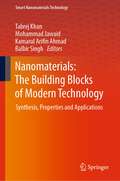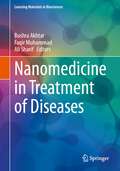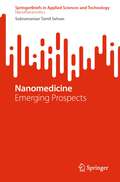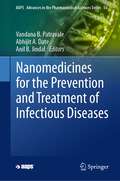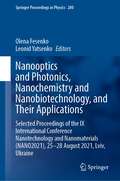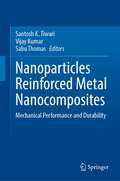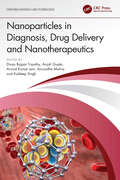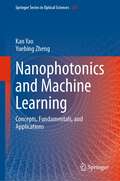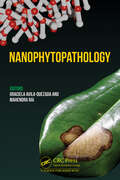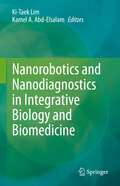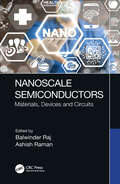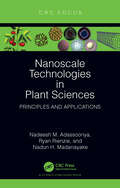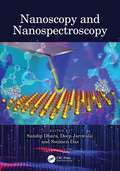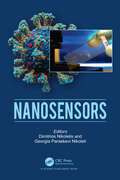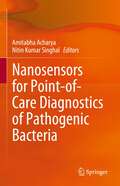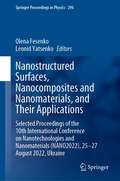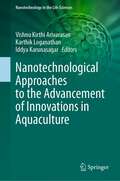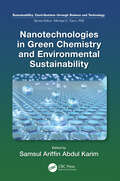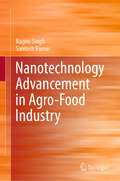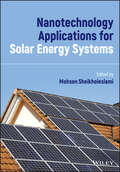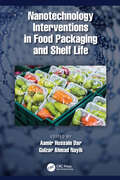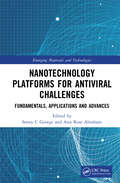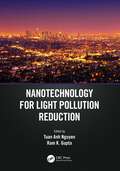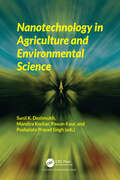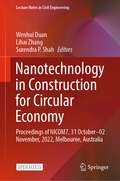- Table View
- List View
Nanomaterials: Synthesis, Properties and Applications (Smart Nanomaterials Technology)
by Mohammad Jawaid Tabrej Khan Kamarul Arifin Ahmad Balbir SinghThis book provides a general overview of different classes of nanomaterials, which includes the synthesis, fabrication, characterization, properties and technological applications of these materials. The book covers 4 main types of nanomaterials, namely: A) soft nanomaterials, B) biological nanomaterials, C) composite nanomaterials and D) green nanomaterials, where for each nanomaterials, a complete guide to material synthesis, characterization, their unique properties (as compared to a conventional bulk material) and potential technological applications is presented. One of the book's most notable characteristics is the inclusion of a section, a special focus on the future of nanomaterials for next-generation technology in electronic, power and energy devices. The content of this book is presented in a simple and lucid style which can also be used by professionals, scientists and students who are interested in the general research area of nanomaterials technology.
Nanomedicine in Treatment of Diseases (Learning Materials in Biosciences)
by Bushra Akhtar Faqir Muhammad Ali SharifNanomedicine biotechnology is applied to and used to study drug development, working mechanisms, diagnosis, and therapies. This textbook particularly written for biomedical applications of nanomedicine covers the whole range of disease treatments related to nanomedicine. This book serves the purpose of highlighting the current advancements of nanomedicines-based regimens which may be employed in disease treatment while it also contains the fundamental knowledge for biomedical researchers from all levels. Each chapter starts with an introduction/theory into the specified approaches for various disease states followed by detailed discussions for a comprehensive understanding. This book best suits advanced level students, but also provides an excellent updated material for researchers and healthcare workers related to nanomedicine and diseases treatment.
Nanomedicine: Emerging Prospects (SpringerBriefs in Applied Sciences and Technology)
by Subramanian Tamil SelvanThis book highlights the emerging paradigm of nanomedicine, intersecting two burgeoning fields of nanotechnology and medicine. Numerous publications have appeared in the literature over the years, especially in cancer nanomedicine. In a boarder sense, nanomedicine aims to apply the knowledge and tools of nanotechnology in a mission to diagnose early and prevent or treat diseases using biocompatible nanoparticles (NPs). Current research in nanomedicine and its prospects depend on creating new breakthroughs at the nexus of nanomaterials and biological systems, making use of non-toxic NPs and nano/biomaterials as smart theranostic systems for a variety of diseases including cancer, neurodegenerative, orthopedic, and cardiac diseases. This book provides a review on recent advancements of nanomedicine in the aforementioned emerging areas of nanomedicine.
Nanomedicines for the Prevention and Treatment of Infectious Diseases (AAPS Advances in the Pharmaceutical Sciences Series #56)
by Vandana B. Patravale Anil B. Jindal Abhijit A. DateThe COVID-19 pandemic has altered the world and reiterated the perpetual need for the development of effective strategies for the prevention and treatment of infectious diseases. While globally prevalent infectious diseases receive extensive attention in terms of drug development and delivery, the neglected and/or emerging infectious diseases that affect developing countries are often overlooked. Additionally, the therapeutic efficacy of existing anti-infective agents is often limited due to sub-optimal biopharmaceutical properties, sub-therapeutic levels of the drugs at the infection site due to various physiological barriers, the expulsion of the drug by efflux transporters, and the emergence of drug-resistant strains.From the commercialization of AmBisome® to the emergency authorization of mRNA-based vaccines, nanotechnology has played a vital role in the prevention and treatment of infectious diseases. More importantly, nanotechnology has enabled the effective utilization of existing armamentarium against infectious diseases leading to improved therapeutic outcomes with a concomitant reduction in the side effects associated with anti-infective agents. In particular, nanotechnology can bring about a paradigm shift in the management of neglected and emerging infectious diseases and may compensate for the lack of drug discovery efforts. While there are several books dedicated to pharmaceutical and/or biomedical applications of nanotechnology or nanotechnology for cancer therapy a comprehensive book focusing on the prevention and/or treatment of viral, bacterial, fungal, and parasitic infections is not available. This book addresses an unmet need in pharmaceutical and medical education.This book provides a comprehensive and up-to-date overview of the latest advancements in nanomedicine, which show great potential for preventing and treating infectious diseases. Covering a wide range of topics, it explores various formulation strategies for combating microbial, fungal, parasitic, and viral infections. The book emphasizes the advantages of nano-scale vaccines over traditional ones and discusses their production. It also examines feasible treatment approaches for diseases like malaria, trypanosomiasis, candidiasis, Hepatitis B, HIV, and the ongoing COVID-19 pandemic. Additionally, it highlights the role of nano-adjuvants in vaccine development, as well as the use of peptide antibiotics and pulmonary delivery of drugs, which open up new possibilities in fighting infectious diseases. Furthermore, the book explores the critical role of nanomedicine in addressing veterinary parasitic infections. The emergence of nanotechnology has led to novel strategies for diagnosing, treating, and preventing parasitic infections in animals.In summary, this book offers a comprehensive description of clinically viable and investigational nanotechnology-enabled medicines (nanomedicines) for the prevention and treatment of globally prevalent, neglected, and emerging infectious diseases.
Nanooptics and Photonics, Nanochemistry and Nanobiotechnology, and Their Applications: Selected Proceedings of the IX International Conference Nanotechnology and Nanomaterials (NANO2021), 25–28 August 2021, Lviv, Ukraine (Springer Proceedings in Physics #280)
by Leonid Yatsenko Olena FesenkoThis book highlights some of the latest advances in nanotechnology and nanomaterials from leading researchers in Ukraine, Europe and beyond. It features contributions presented at the 8th International Science and Practice Conference Nanotechnology and Nanomaterials (NANO2020), which was held on August 25–28, 2021 at Lviv Polytechnic National University, and was jointly organized by the Institute of Physics, the National Academy of Sciences of Ukraine, Lviv Polytechnic National University, University of Tartu (Estonia), University of Turin (Italy), Pierre and Marie Curie University (France), European Profiles S.A. (Greece), Representation of the Polish Academy of Sciences in Kyiv, University of Angers (France), Ruprecht Karl University of Heidelberg (Germany). Internationally recognized experts from a wide range of universities and research institutions share their knowledge and key findings on material properties, behavior, and synthesis. This book’s companion volume also addresses topics such as nano-optics, energy storage, and biomedical applications.
Nanoparticles Reinforced Metal Nanocomposites: Mechanical Performance and Durability
by Sabu Thomas Vijay Kumar Santosh K. TiwariThis book highlights recent developments related to fabrication and utilization of nanoparticle-engineered metal matrices and their composites linked to the heavy industries, temperature fasteners, high-pressure vessels, and heavy turbines, etc. The mechanical properties of newly developed metallic composites are discussed in terms of tensile modulus, hardness, ductility, crack propagation, elongation, and chemical inertness. This book presents the design, development, and implementation of state-of-the-art methods linked to nanoparticle-reinforced metal nanocomposites for a wide variety of applications. Therefore, in a nutshell, this book provides a unique platform for researchers and professionals in the area of nanoparticle-reinforced metal nanocomposites.
Nanoparticles in Diagnosis, Drug Delivery and Nanotherapeutics (Emerging Materials and Technologies)
by Anuradha Mishra Arvind Kumar Jain Kuldeep Singh Divya Bajpai Tripathy Anjali GuptaThe integration of nanotechnology with biomaterials, diagnostic tools, analytical equipment, physiotherapy kits, and drug delivery agents has resulted in nanotherapeutics illustrated as a class of medicine with potential of research and development. This book illustrates synthesis, properties, and applications of nanotherapeutics in various healthcare-related issues including treatment of cancer, Alzheimer’s disease, targeted drug delivery, anti-HIV-1 nanotherapeutics, antibacterial/antiviral agents, skin therapy, and hyperthermia. Features: Consolidates different aspects of nanoparticles such as synthesis and types of nanotherapeutics in a detailed manner. Presents categorical classification of nanoparticles as therapeutics. Covers the sustainability of nanotherapeutics. Reviews fabrication and advancement of all categories of nanotherapeutics. Discusses specific applications such as in cancer therapy, skin treatments, and targeted drug delivery. This book is aimed at researchers, professionals, and senior undergraduate students in materials and medical science, biomedical engineering, and nanotechnology
Nanophotonics and Machine Learning: Concepts, Fundamentals, and Applications (Springer Series in Optical Sciences #241)
by Kan Yao Yuebing ZhengThis book, the first of its kind, bridges the gap between the increasingly interlinked fields of nanophotonics and artificial intelligence (AI). While artificial intelligence techniques, machine learning in particular, have revolutionized many different areas of scientific research, nanophotonics holds a special position as it simultaneously benefits from AI-assisted device design whilst providing novel computing platforms for AI. This book is aimed at both researchers in nanophotonics who want to utilize AI techniques and researchers in the computing community in search of new photonics-based hardware. The book guides the reader through the general concepts and specific topics of relevance from both nanophotonics and AI, including optical antennas, metamaterials, metasurfaces, and other photonic devices on the one hand, and different machine learning paradigms and deep learning algorithms on the other. It goes on to comprehensively survey inverse techniques for device design, AI-enabled applications in nanophotonics, and nanophotonic platforms for AI. This book will be essential reading for graduate students, academic researchers, and industry professionals from either side of this fast-developing, interdisciplinary field.
Nanophytopathology
by Mahendra Rai Graciela Avila-QuezadaThe book entitled ‘Nanophytopathology’ discusses the need for alternative technologies particularly smart nanotechnological tools including nanobiosensor in the detection of plant diseases, delivery of fungicides/pesticides, and therapy for the diseases caused by plant pathogens and pests. The use of nanomaterials will minimize the huge amount of application of pesticides and fungicides thereby reducing environmental pollution. This technology is eco-friendly, economically viable, and useful for sustainable crop production. The book encompasses chapters written by experienced experts in respective fields, which provide up-to-date knowledge about pathogen/pest control using nanotechnology. It will be essential reading for post-graduate students and researchers, agriculture scientists, nanotechnologists, microbiologists, green chemistry experts, and biotechnologists.
Nanorobotics and Nanodiagnostics in Integrative Biology and Biomedicine
by Kamel A. Abd-Elsalam Ki-Taek LimNanorobotics and Nanodiagnostics in Integrative Biology and Biomedicine "Nanorobotics and nanodiagnostics” can be defined as a new generation of biohybrid and nanorobotics that translate fundamental biological principles into engineering design rules, or integrative living components into synthetic structures to create biorobots and nanodiagnotics that perform like natural systems. Nanorobots or nanobots are structured of a nanoscale made of individual assemblies. They can be termed as intelligent systems manufactured with self-assembly strategies by chemical, physical and biological approaches. The nanorobot can determine the structure and enhance the adaptability to the environment in interdisciplinary tasks."Nanorobotics and nanodiagnostics" is a new generation of biohybrid that translates fundamental biological principles into engineering design rules to create biorobots that perform like natural systems. These biorobotics and diagnostics can now perform various missions to be accomplished certain tasks in the research areas such as integrative biology and biomedicine. "Nanorobotics and Nanodiagnostics in Integrative Biology and Biomedicine" sheds light on a comprehensive overview of the multidisciplinary areas that explore nanotherapeutics and nanorobotic manipulation in biology and medicine. It provides up-to-date knowledge of the promising fields of integrative biology and biomedicine for nano-assisted biorobotics and diagnostics to detect and treat diseases that will enable new scientific discoveries.
Nanoscale Semiconductors: Materials, Devices and Circuits
by Balwinder Raj Ashish RamanThis reference text discusses conduction mechanism, structure construction, operation, performance evaluation and applications of nanoscale semiconductor materials and devices in VLSI circuits design.The text explains nano materials, devices, analysis of its design parameters to meet the sub-nano-regime challenges for CMOS devices. It discusses important topics including memory design and testing, fin field-effect transistor (FinFET), tunnel field-effect transistor (TFET) for sensors design, carbon nanotube field-effect transistor (CNTFET) for memory design, nanowire and nanoribbons, nano devices based low-power-circuit design, and microelectromechanical systems (MEMS) design.The book discusses nanoscale semiconductor materials, device models, and circuit design covers nanoscale semiconductor device structures and modeling discusses novel nano-semiconductor devices such as FinFET, CNTFET, and Nanowire covers power dissipation and reduction techniques Discussing innovative nanoscale semiconductor device structures and modeling, this text will be useful for graduate students, and academic researchers in diverse areas such as electrical engineering, electronics and communication engineering, nanoscience, and nanotechnology. It covers nano devices based low-power-circuit design, nanoscale devices based digital VLSI circuits, and novel devices based analog VLSI circuits design.
Nanoscale Technologies in Plant Sciences: Principles and Applications
by Nadeesh M. Adassooriya Ryan Rienzie Nadun H. MadanayakeThis book provides a detailed review on the interactions of nanomaterials with plants, nanodelivery systems in agriculture, the impacts of nanomaterials on seed germination, nanosensors for plant disease diagnosis and toxicity aspects of nanomaterials towards plants. In addition, nanomaterials synthesis and nanomaterials characterisation techniques, are discussed. This book also highlights practical aspects related to these subsections. The content of this text will help a diverse group of researchers to apply nanotechnology concepts in life sciences. Although there are numerous books available on the subject, they mostly discuss recent research findings and very few covers the fundamentals and applications. This book will be advantageous for budding scientists who are interested in the field of plant nanomaterial interactions. It is obvious that current literature on nanotechnology has a bias towards chemistry and physics which creates a barrier for biologists to pursue nanosciences. This book attempts to address the aforementioned challenge.
Nanoscopy and Nanospectroscopy
by Sandip Dhara Deep Jariwala Soumen DasThis book builds a narrative on the near-field optical and spectroscopic studies with an emphasis on plasmonic- and photonic-assisted nano-optics as a tool for superlensing. Deliberations on near-field studies using confined light in various applications are included along with their commercial implications. Single-molecule detection utilizing efficient surface-enhanced Raman scattering phenomenon in the far-field and plasmonic tip-enhanced Raman scattering studies in the near-field measurements for fast analysis up to trace level is discussed. Features: Covers the broad area of nano-optical spectroscopy from the perspective of putting the concepts and innovations in the field to use. Discusses entire spectra of near-field optics and spectroscopy using light. Explores gas/chemical sensing using surface plasmon resonance (SPR) in the Kretschmann configuration. Includes dielectric nano-photonics and optical confinement. Studies phonon behaviour using confined light for the analysis of chemical, biological, and other materials. This book is aimed at graduate students and researchers in material science, analytical chemistry, nanotechnology, and electrical engineering.
Nanosensors
by Dimitrios Nikolelis Georgia Paraskevi NikoleliNanotechnology and biosensors show how nanotechnology is used to create affordable, mass-produced, portable, small-sized nanosensors to directly monitor food toxicants and environmental pollutants. In addition, it provides the market with systems for applications in food analysis, environmental monitoring and health diagnostics. Nanotechnology has led to a dramatic improvement in the performance, sensitivity and selectivity of biosensor devices. Metal-oxides and carbon nanostructures, gold and magnetite nanoparticles, and the integration of dendrimers in biosensors using nanotechnology, have contributed greatly to making nanosensors more effective and affordable in the market. This book provides a timely resource on the subject.
Nanosensors for Point-of-Care Diagnostics of Pathogenic Bacteria
by Amitabha Acharya Nitin Kumar SinghalThis book comprehensively reviews various nanodiagnostic approaches for the detection of bacterial pathogens. The initial chapter of the book discusses receptors present on bacterial cell surfaces that can be targeted for diagnostic applications. The book then presents different fluorescent nanoparticle systems that are used for bacterial detection. Further, it covers surface plasmon resonance (SPR), ELISA, and QCM-based nanosensors to detect pathogenic bacteria. It examines different nanosensors used for the microfluidic-based detection of bacterial pathogens, including microfluidic paper-based analytical devices (μPADs), lateral flow devices, and miniaturized PCR devices. The book also covers the current electrochemical, voltammetric, and amperometric nanosensors-based microorganism recognition approaches. Lastly, the book summarizes the current challenges and the futuristic application of nanosensors to detect bacterial pathogens. This book is an invaluable resource for all medical laboratories and clinical institutions dealing with infectious diseases.
Nanostructured Surfaces, Nanocomposites and Nanomaterials, and Their Applications: Selected Proceedings of the 10th International Conference on Nanotechnologies and Nanomaterials (NANO2022), 25—27 August 2022, Ukraine (Springer Proceedings in Physics #296)
by Leonid Yatsenko Olena FesenkoThis book highlights some of the latest advances in nanotechnology and nanomaterials from leading researchers in Ukraine, Europe and beyond. It features contributions presented at the 10th International Science and Practice Conference Nanotechnology and Nanomaterials (NANO2022), which was held in hybrid format on August 25-27, 2022 at Lviv House of Scientists, and was jointly organized by the Institute of Physics of the National Academy of Sciences of Ukraine, University of Tartu (Estonia), University of Turin (Italy), and Pierre and Marie Curie University (France). Internationally recognized experts from a wide range of universities and research institutions share their knowledge and key findings on material properties, behavior, synthesis and their applications.The book will be interesting for leading scientists, advanced undergraduate and graduate students in material and nanoscience. This book’s companion volume also addresses topics such as nano-optics, nanoelectronics, energy storage, nanochemistryl and biomedical applications.
Nanotechnological Approaches to the Advancement of Innovations in Aquaculture (Nanotechnology in the Life Sciences)
by Vishnu Kirthi Arivarasan Karthik Loganathan Iddya KarunasagarThe main practical breakthrough of this century is nanobiotechnology, an amalgamation of biology and nanotechnology based on the standards and methods of metabolism. The field mainly involves the analysis, synthesis and the links between molecular biology, nutritional science and nanotechnology. In addition, the field involves the links between other life sciences branches, since the improvement of nanotechnology strategies might be directed by considering the structure and the capability of nanoparticles present in the living cells. This book is a comprehensive evaluation of the latest nanobiotechnological developments, with an emphasis on applications, especially in aquaculture. It outlines, in-depth, modern techniques, and includes a variety of important sources that make this the perfect resource for researchers in this captivating world of nanobiotechnology.
Nanotechnologies in Green Chemistry and Environmental Sustainability (Sustainability: Contributions through Science and Technology)
by Abdul Karim, Samsul AriffinNanotechnologies represent a fast-growing market and this unique volume highlights the current studies in applied sciences on sustainability of green science and technology. The chapters include modelling, machine learning, nanotechnology, nanofluids, nanosystems, smart materials and applications and solar and fuel cells technology. The authors cover simulation, additive manufacturing, machine learning and the autonomous system. Various aspects of green science as well as trans-disciplinary topics between fundamental science and engineering are presented.The book is suitable for all postgraduates and researchers working in this rapid growing research area. Features Presenting latest research on green materials and sustainability. Provide in depth discussion on modeling and simulation using latest techniques. Technical exposure for the readers on additive manufacturing principles. Numerous examples on nanofluids and nano technology are presented. Discusses computer modeling, superconductivity, nanotubes and related structures such as graphene.
Nanotechnology Advancement in Agro-Food Industry
by Santosh Kumar Ragini SinghThis book provides a comprehensive insight into the growth of nanotechnology in the agri-food industry. Currently, nanotechnology serves as the most promising means to resolve the issues encountered in the food sector, as it enables the production of high-quality food with exceptional characteristics such as extended shelf life, flavor, freshness, and high nutritional content. This book focuses on the applications of nanotechnology in various fields such as smart packaging, processing, and preservation of food. It also emphasizes the role of nanomaterials in strategic design of nutraceuticals and functional foods. Along with providing an overview of the innovations and application, this book also describes future perspectives, and offers insights to ensure consumer confidence in terms of safe use. In this context the application of nanomaterials as nanosensors is additional covered. The book provides readers with a deep knowledge regarding nanomaterials-based biosensors (colorimetric, electrochemical, fiber-based) for detection of pathogens in contaminated food. Factors affecting risk assessment regulations and safety concerns regarding the use of nanomaterials in food industry have also been discussed in detail. Given its scope, this book appeals to a wider readership, especially for researchers and students who work in food agronomy and nanomaterials and nanotechnology related fields.
Nanotechnology Applications for Solar Energy Systems
by Mohsen SheikholeslamiNanotechnology Applications for Solar Energy Systems Understand the latest developments in solar nanotechnology with this comprehensive guide Solar energy has never seemed a more critical component of humanity’s future. As global researchers and industries work to develop sustainable technologies and energy sources worldwide, the need to increase efficiency and decrease costs becomes paramount. Nanotechnology has the potential to play a considerable role in meeting these challenges, leading to the development of solar energy systems that overcome the limitations of existing technologies. Nanotechnology Applications for Solar Energy Systems is a comprehensive guide to the latest technological advancements and applications of nanotechnology in the field of solar energy. It analyzes nanotechnology applications across a full range of solar energy systems, reviewing feasible technological advancements for enhanced performance of solar energy devices, and discussing emerging nanomaterials such as graphene and graphene derivatives. Nanotechnology Applications for Solar Energy Systems readers will also find: Detailed treatment of nanotechnology applications in systems including solar concentrating collectors, linear Fresnel reflectors, parabolic trough collectors, and more Coverage of methods to enhance the performance of solar energy devices including solar ponds and solar steam generators A comprehensive review of nanomaterials classification and the properties of nanomaterials in heat transfer and efficiency enhancement Nanotechnology Applications for Solar Energy Systems is critical for researchers in fields related to solar energy, engineers and industry professionals developing solar technology, and academics working in related fields such as chemistry, physics, materials science, and electrical engineering.
Nanotechnology Interventions in Food Packaging and Shelf Life
by Aamir Hussain DarNanotechnology has revolutionized agriculture and food technology, improving the shelf life of foods through interventions of nanomaterials in the packaging. Smart materials, biosensors, nanobiosenors, packaging materials, nanocarbon dots, and nanodevices address aspects of the food industry, such as food safety, food security, and packaging and shelf life.Nanotechnology Interventions in Food Packaging and Shelf Life shows how nanotechnology has the potential to transform food packaging materials in the future.Nanotechnology applied to food packaging can increase the shelf life of foods, minimize spoilage, ensure food safety, and repair damaged packaging. Key Features Sheds light on benefits of nanotechnology in the food packaging industry Contains information on utilization of nanocellulose and nanofibrils in food packaging Provides an overview of nanosensor applications for shelf-life extension of different food materials This book presents a comprehensive review of new innovations in nanotechnology, packaging, preservation, and processing of food and food products. It serves as a useful tool for food engineers and technologists in the food packaging industry.
Nanotechnology Platforms for Antiviral Challenges: Fundamentals, Applications and Advances (Emerging Materials and Technologies)
by Soney C George and Ann Rose AbrahamNanotechnology provides an innovative platform for drug delivery and antiviral actions. This book discusses the utilization of nano-based formulations for the control of viral agents. The antiviral potential of green synthesized silver, chitosan nanoparticles encapsulating curcumin, photoinduced antiviral carbon nanohorns, and the role of carbon-based materials like fullerenes, and carbon nanotubes in the repression of viral antigens are explained. The book also covers nanomaterial-based solutions for SARS-CoV-2 and other viral infections. Features: Explains theory and practical applications of nanomaterials as antiviral agents. Reviews upscaling of nanomaterials from laboratory to fabrication stage. Illustrates nanocurcumin, silver nanoparticles, and carbon nanoparticles for biomedical applications. Highlights role of nanotechnology in effectively combating viral infections and pandemics. Includes case studies of specific pharma companies. This book is aimed at researchers, graduate students in materials science, microbiology and virology, and pharmaceutical sciences.
Nanotechnology for Light Pollution Reduction
by Ram K. Gupta Tuan Anh NguyenLight is essential for living organisms; however, excessive light causes adverse health conditions. This book covers the most recent progress on nanotechnology for reducing light pollution, discussing many approaches and technologies for controlling light pollution.The book explores the fundamentals of light and the causes of light pollution, delving into light pollution’s social, economic, and ecological impacts, its effects on living beings and the environment, as well as possible solutions and methods of control. The text discusses smart lighting technology, covering the various smart nanomaterials, nanosensors, and nanodevices involved. It also explores smart lighting involving natural light from the sun, artificial skydomes, shadow-free/secondary light sources, and the basics of many emerging devices such as light-emitting diodes and photosensors.Nanotechnology is key to providing a new route for the next generation of lighting devices and systems with reduced light pollution. This essential reference illuminates emerging technologies and their applications, providing new directions to scientists, researchers, and students to better understand the principles, technologies, and applications of nanotechnology in light pollution.
Nanotechnology in Agriculture and Environmental Science
by Pawan Kaur Sunil K. Deshmukh Mandira Kochar Pushplata Prasad SinghThis book provides examples applications of nanotechnology in addressing problems and challenges in agriculture as well as environmental sciences and provides an overview of innovations in nanopesticides, nanofertilizers, bionanosensors and nano-based delivery system for improving different aspects of plant productivity including pre-harvest and post-harvest strategies as well detection of contaminants that could be useful for enhancing soil health. Recycling of agricultural waste to beneficial products using nanotechnologies; bionanosensors; fate of nanomaterials and the ecological consequences of their delivery into the environment; safety and nanotoxicity issues are other topics being dealt with in this book. Chapters have been written by internationally recognized researchers and experts with special reference to the innovations and latest developments in the mentioned areas of nanobiotechnology that have applications and commercial importance, especially for crop fields and post-harvest management. Despite the research and development used to promote the use of nanotechnology in agriculture and the environmental, knowledge gaps and uncertainties about how to fill the gaps are more prevalent than scientific certainties about the public health and environmental effects of nanomaterials. The book thus addresses the issue of toxicity of nanomaterials in agricultural nanotechnology products. The book will be useful for active researchers and scientists in the agricultural sector, academia as well as industry, including nanotechnologists, plant pathologists, agronomists, agrochemists, environmental technologists and all scientists working for sustainability in agriculture. The book will encourage future and active researchers and scientists in the agriculture sector, academia as well as industry.
Nanotechnology in Construction for Circular Economy: Proceedings of NICOM7, 31 October–02 November, 2022, Melbourne, Australia (Lecture Notes in Civil Engineering #356)
by Surendra P. Shah Lihai Zhang Wenhui DuanThis open access book covers emerging opportunities and future use of nanotechnology in construction, including deep advances in cement chemistry, nanotechnology, artificial intelligence, robotics, concrete technology, and extreme engineering (blast, impact and fire). The proceedings also presents sectorial interactions within the traditional construction industry supply chain, enabled by the dynamic partnership between international industry, government agencies, and universities. Nanotechnology has transformed the construction materials industry into an advanced manufacturing sector to address climate change and carbon neutrality challenges by delivering sustainable and resilient infrastructure assets. Hence, this book reports specific advances in nanoscience and nano-engineering, and their impacts on numerous novel construction materials including binders, additives, high-performance concrete materials, concrete structural systems, polymer composites, and pavement materials.
